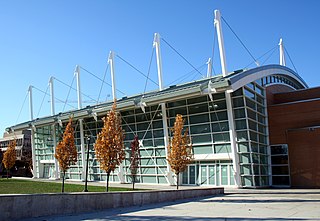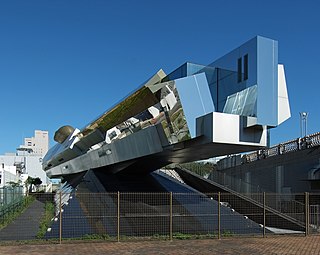External links
Elements of Japanese architecture | ||||||||||
|---|---|---|---|---|---|---|---|---|---|---|
| Styles |
| |||||||||
| Types of building |
| |||||||||
| Roof styles | ||||||||||
| Structural and spatial | ||||||||||
| ||||||||||
| Rooms | ||||||||||
| Furnishings | ||||||||||
| Partitions | ||||||||||
| Outdoor objects | ||||||||||
| Measurements | ||||||||||
| Organizations | ||||||||||
| Related topics |
| |||||||||
一般社団法人日本建築学会 | |
| Abbreviation | AIJ |
|---|---|
| Formation | 1886 |
| Type | Learned society |
| Headquarters | Tokyo |
| Location |
|
Official language | Japanese |
President | Nobuaki Furuya |
| Website | https://www.aij.or.jp/aijhome.htm |
The Architectural Institute of Japan, or AIJ, is a Japanese professional body for architects, building engineers, and researchers in architecture.
The institute was founded in 1886 as an institute for architects. It was renamed the Architectural Institute in 1905, and given its present name in 1947.
Today the institute has about 38,000 members. Its mission is to advance the science and technology of architecture through mutual collaboration by its members. It sponsors roughly 600 sub-committees and working groups under 16 standing research committees. The institute's central office and library is in Tokyo with nine regional chapters (Hokkaido, Tohoku, Kanto, Tokai, Hokuriku, Kinki, Chugoku, Shikoku and Kyushu). [1]
The institute publishes the Journal of Architecture and Building Science, Transactions of AIJ, Selected Architectural Designs of the Architectural Institute of Japan, the AIJ Journal of Technology and Design, Summaries of Technical Papers of Annual Convention, the Journal of Asian Architecture and Building Engineering (JAABE), and technical standards and specifications for the architectural design and construction professions. It also publishes the results of research committee studies, terminology dictionaries, textbooks, slides, videotapes, and books for the general public. [1]
Prizes awarded by the institute for individual achievement, built work, and research are among the most prestigious in the industry. [2]

An architect is a person who plans, designs, and oversees the construction of buildings. To practice architecture means to provide services in connection with the design of buildings and the space within the site surrounding the buildings that have human occupancy or use as their principal purpose. Etymologically, the term architect derives from the Latin architectus, which derives from the Greek, i.e., chief builder.

The Massachusetts Institute of Technology (MIT) is a private land-grant research university in Cambridge, Massachusetts. Established in 1861, MIT has played a significant role in the development of many areas of modern technology and science.

The KTH Royal Institute of Technology, abbreviated KTH, is a public research university in Stockholm, Sweden. KTH conducts research and education in engineering and technology and is Sweden's largest technical university. Currently, KTH consists of five schools with four campuses in and around Stockholm.

Helsinki University of Technology was a technical university in Finland. It was located in Otaniemi, Espoo in the Helsinki metropolitan area. The university was founded in 1849 by Grand Duke of Finland, Emperor Nicholas I and received university status in 1908. It moved from Helsinki to Otaniemi campus area in 1966. The merger of HUT with two other schools created the Aalto University in 2010, and HUT briefly held the name Aalto University School of Science and Technology before being split into four schools in 2011.

Illinois Institute of Technology, commonly referred to as Illinois Tech and IIT, is a private research university in Chicago, Illinois. Tracing its history to 1890, the present name was adopted upon the merger of the Armour Institute and Lewis Institute in 1940. The university has programs in architecture, business, communications, design, engineering, industrial technology, information technology, law, psychology, and science. It is classified among "R2: Doctoral Universities – High research activity".

The Delft University of Technology is the oldest and largest Dutch public technical university, located in Delft, The Netherlands. It specializes in engineering, technology, computing, design, and natural sciences.

Technische Universität Berlin is a public research university located in Berlin, Germany. It was the first German university to adopt the name "Technische Universität".

The American Philosophical Society (APS) is an American scholarly organization and learned society founded in 1743 in Philadelphia that promotes knowledge in the humanities and natural sciences through research, professional meetings, publications, library resources, and community outreach. It was founded by the polymath Benjamin Franklin and is considered the first learned society founded in what became the United States.

Aarhus University is a public research university with its main campus located in Aarhus, Denmark. It is the second largest and second oldest university in Denmark. The university is part of the Coimbra Group, the Guild, and Utrecht Network of European universities and is a member of the European University Association.

The Royal Institute of British Architects (RIBA) is a professional body for architects primarily in the United Kingdom, but also internationally, founded for the advancement of architecture under its royal charter granted in 1837, three supplemental charters and a new charter granted in 1971.

The National (Metsovian) Technical University of Athens, sometimes known as Athens Polytechnic, is among the oldest higher education institutions of Greece and the most prestigious among engineering schools. It is named Metsovio(n) in honor of its benefactors Nikolaos Stournaris, Eleni Tositsa, Michail Tositsas and Georgios Averoff, whose origin is from the town of Metsovo in Epirus.

Graduate School of Architecture, Planning and Preservation (GSAPP) is the architecture school of Columbia University, a private research university in New York City. It is also home to the Masters of Science program in Advanced Architectural Design, Historic Preservation, Real Estate Development, Urban Design, and Urban Planning.

The Budapest University of Technology and Economics, official abbreviation BME, is a public research university located in Budapest, Hungary. It is the most significant university of technology in the country and is considered the world's oldest institute of technology which has university rank and structure. It was founded in 1782.

Osaka Institute of Technology, abbreviated as Dai kōdai (大工大), Han kōdai (阪工大), or Osaka kōdai (大阪工大) is a private university in Osaka Prefecture, Japan. OIT has 3 campuses, Omiya campus located in Asahi-ku, Osaka City, Umeda campus located in Kita-ku, Osaka City and Hirakata campus located in Hirakata City.

Kyoto Institute of Technology in Kyoto, Japan is a Japanese national university established in 1949. The Institute's history extends back to two schools, Kyoto Craft High School and Kyoto Sericulture Training School, which were forerunners of the Faculty of Engineering and Design and the Faculty of Textile Science, respectively. The former was moved to Sakyo-ku, Matsugasaki in 1930 and changed its name to Kyoto Industrial High School in 1944. The latter developed into Kyoto Sericulture High School, under supervision of the Ministry of Education in 1914, and changed its name to Kyoto Sericulture Technical High School in 1931 and then to Kyoto Technical High School of Sericulture in 1944. The two forerunners merged in 1949, due to educational system revisions, to establish the present School of Science and Technology. Together with Shinshu University and Tokyo University of Agriculture and Technology, the Institute is one of Japan's three historical centers of textile research.

The MIT School of Architecture and Planning is one of the five schools of the Massachusetts Institute of Technology in Cambridge, Massachusetts. Founded in 1865 by William Robert Ware, the school offered the first architecture curriculum in the United States and was the first architecture program established within a university. MIT's Department of Architecture has consistently ranked among the top architecture/built environment schools in the world.

Architectural engineering or architecture engineering, also known as building engineering, is a discipline that deals with the engineering and construction of buildings, such as environmental, structural, mechanical, electrical, computational, embeddable, and other research domains. It is related to Architecture, Mechatronics Engineering, Computer Engineering, Aerospace Engineering, and Civil Engineering, but distinguished from Interior Design and Architectural Design as an art and science of designing infrastructure through these various engineering disciplines, from which properly align with many related surrounding engineering advancements.
The Cal Poly Pomona College of Environmental Design is a college part of the California State Polytechnic University, Pomona. The college houses over 1,600 students; making it one of largest environmental design programs in the United States. The college offers bachelor's degrees in five departments, as well as three master's degree programs. It is the only academic unit within the California State University system to be associated with a Pritzker Prize laureate.

Makoto Sei Watanabe is a Japanese architect living in Tokyo. He designed such buildings as Japan's K Museum, has lectured at universities around Japan, and won many awards for his designs. He is the author of The Induction Cities, published in 2002.

New Classical architecture, New Classicism or Contemporary Classical architecture is a contemporary movement in architecture that continues the practice of Classical architecture. It is sometimes considered the modern continuation of Neoclassical architecture, even though other styles might be cited as well, such as Gothic, Baroque, Renaissance or even non-Western styles – often referenced and recreated from a postmodern perspective as opposed to being strict revival styles.